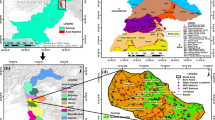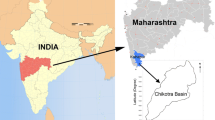Abstract
Electrical resistivity method is a versatile and economical technique for groundwater prospecting in different geological settings due to wide spectrum of resistivity compared to other geophysical parameters. Exploration and exploitation of groundwater, a vital and precious resource, is a challenging task in hard rock, which exhibits inherent heterogeneity. In the present study, two-dimensional Electrical Resistivity Tomography (2D-ERT) technique using two different arrays, viz., pole–dipole and pole–pole, were deployed to look into high signal strength data in a tectonically disturbed hard rock ridge region for groundwater. Four selected sites were investigated. 2D subsurface resistivity tomography data were collected using Syscal Pro Switch-10 channel system and covered a 2 km long profile in a tough terrain. The hydrogeological interpretation based on resistivity models reveal the water horizons trap within the clayey sand and weathered/fractured quartzite formations. Aquifer resistivity lies between ∼3–35 and 100–200 Ωm. The results of the resistivity models decipher potential aquifer lying between 40 and 88 m depth, nevertheless, it corroborates with the static water level measurements in the area of study. The advantage of using pole–pole in conjunction with the pole–dipole array is well appreciated and proved worth which gives clear insight of the aquifer extent, variability and their dimension from shallow to deeper strata from the hydrogeological perspective in the present geological context.










Similar content being viewed by others
References
Abdulaziz A M, Hurtado J M and Faid A 2012 Hydrogeological characterization of Gold Valley: An investigation of precipitation recharge in an intermountain basin in the Death Valley region, California, USA; Hydrogeol. J. 20(4) 701–718.
Adepelumi A A, Yi M J, Kim J H, Ako B D and Son J S 2006 Integration of surface geophysical methods for fracture detection in crystalline bedrocks of southwestern Nigeria; Hydrogeol. J. 14 1284–1306.
Batayneh Awni T 2001 Resistivity imaging for near-surface resistive dyke using two-dimensional DC resistivity techniques; J. Appl. Geophys. 48 25–32.
Bhattacharya P K and Patra H P 1968 Direct current geoelectric sounding: Principles and interpretation; Methods in Geochem. Geophys., Series-9. Elsevier Publishing Company, 135p.
Daily W, Ramirez A, Binley A and Labrecque D 2004 Electrical Resistance Tomography; The Leading Edge 23(5) 438–442.
Giao P H, Chung S G, Kim D Y and Tanaka H 2003 Electric imaging and laboratory resistivity testing for geotechnical investigation of Pusan clay deposits; J. Appl. Geophys. 52 157–175.
Griffiths D H and Barker R D 1993 Two-dimensional resistivity imaging and modeling in areas of complex geology; J. Appl. Geophys. 29 211–226.
IGGS Report on Resistivity Survey for sitting a borewell location for rain water harvesting in Hamdard University Campus, New Delhi submitted by IGIS Sarita Vihar, New Delhi, 2001, 17p.
Jupp D L B and Vozoff K 1975 Stable iterative methods for the inversion of geophysical data; Geophys. J. Roy. Astron. Soc. 42 957–976.
Kaur P, Chaudhri N, Raczek I, Kröner A and Hofmann AW 2009 Record of 1.82 Ga Andean-type continental arc magmatism in NE Rajasthan, India: Insights from zircon and Sm–Nd ages, combined with Nd–Sr isotope geochemistry; Gondwana Res. 16 56–71.
Keller G V and Frischknecht F C 1966 Electrical methods in geophysical prospecting; Pergamon Press Inc., Oxford.
Krishnamurthy N S, Kumar D, Negi B C, Jain S C, Dhar R L and Ahmed S 2000 Electrical resistivity investigation in Maheshwaram watershed, A.P., India; Technical Report No. NGRI-2000-GW-287.
Kumar D 2004 Conceptualization and optimal data requirement in simulating flow in weathered-fractured aquifers for groundwater management; Ph.D. Thesis, Osmania University, Hyderabad, 213p.
Kumar D 2012 Efficacy of electrical resistivity tomography technique in mapping shallow subsurface anomaly; J. Geol. Soc. India 80(3) 304–307.
Kumar D, Ahmed S, Krishnamurthy N S and Dewandel B 2007 Reducing ambiguities in vertical electrical sounding interpretations: A geostatistical application; J. Appl. Geophys. 62(1) 16–32.
Kumar D, Aadil N, Chandra S, Sreedevi P D, Khan Haris H, Dutta S, Zaidi F K, Sayed A, Krishnamurthy N S and Ahmed S 2008 Groundwater exploration in Basaltic formations at Ghatiya Watershed, Madhya Pradesh: An integrated study; Technical Report No. NGRI-2008-GW-632.
Kumar D, Rao V A, Nagaiah E, Raju P K, Mallesh D, Ahmeduddin M and Ahmed S 2010 Integrated geophysical study to decipher potential groundwater and Zeolite-bearing zones in Deccan Traps; Curr. Sci. 98(6) 803–814.
Kumar D, Rai S N, Thiagarajan S, Ratna Kumari Y and Bulliabai M 2011 Sensitivity analysis of 2d electrical resistivity data for groundwater exploration in deccan basalt hard rock aquifers; Presented and published in Abstract volume on Andhra Pradesh Science Congress–2011 on focal theme Science for the Society held at Visakhapatnam during 14–16 November 2011, 194p.
Loke M H 1997a Electrical imaging surveys for environmental and engineering studies: A practical guide to 2-D and 3-D surveys; 61p.
Loke M H 1997b Software: RES2DINV. 2D interpretation for DC resistivity and IP for windows 95. Copyright by MH Loke 5, Cangkat Minden Lorong 6, Minden Heights, 11700 Penang, Malaysia.
Marescot L 1995 Electrical surveying. Part-I: Resistivity method; Lecture A. WS0506.
Orellana E and Mooney H M 1966 Master Tables and Curves for Vertical Electrical Sounding Over Layered Structures; Interciencia, Madrid, Spain.
Owen R J, Gwavava O and Gwaze P 2005 Multi-electrode resistivity survey for groundwater exploration in the Harare greenstone belt, Zimbabwe; Hydrogeol. J. 14 244–252.
Parasnis D S 1986 Principles of applied geophysics; 4th edn, Chapman and Hall, London, UK, 402p.
Rao V A, Kumar D, Sarma V S, Khan A A and Ahmed S 2006 Multi-Electrode Resistivity Imaging Survey for groundwater exploration in Jamia Hamdard University Campus, New Delhi, Technical Report No. NGRI-2006-GW-578..
Rao V A, Kumar D, Chandra S, Nagaiah E, Kumar G A, Syed A and Ahmed S 2008 High-Resolution Electrical Resistivity Tomography (HERT) Survey for groundwater exploration at APSP Campus, Dichpally, Nizamabad District, Andhra Pradesh, Technical Report No. NGRI-2008-GW-626.
Ratnakumari Y, Rai S N, Thiagarajan S and Kumar D 2012 2D Electrical resistivity imaging for delineation of deeper aquifers in parts of Chandrabhaga river basin, Nagpur district, Maharashtra, India; Curr. Sci. 102(1) 61–69.
Revil A, Karaoulis M, Johnson T and Kemna A 2012 Review: Some low-frequency electrical methods for subsurface characterization and monitoring in hydrogeology; Hydrogeol. J. 20(4) 617–658.
Rijkswaterstaat 1969 Standard Graphs for Resistivity Prospecting; European Association of Exploration Geophysicists, Hague, The Netherlands.
Robert T, Dassargues A, Brouyère S, Kaufmann O, Hallet V and Nguyen F 2011 Assessing the contribution of electrical resistivity tomography (ERT) and self-potential (SP) methods for a water well drilling program in fractured/karstified limestones; J. Appl. Geophys. 75 42–53.
Sasaki Y 1992 Resolution of resistivity tomography inferred from numerical simulation; Geophys. Prospect. 40 453–464.
Sudha K, Israil M, Mittal S and Rai J 2009 Soil characterization using electrical resistivity tomography and geotechnical investigations; J. Appl. Geophys. 67 74–79.
Zohdy A A R, Eaton G P and Mabey D R 1974 Application of surface geophysics to groundwater investigation, Techniques of Water Resources Investigations, US Geol. Surv., 116p.
Acknowledgements
Authors are thankful to the Director, CSIR –National Geophysical Research Institute, Hyderabad India for his kind permission to carry out the work for societal and research benefit and encouragement to publish the important findings and results of this work. Thanks are also due to Mr. Azhar Ali Khan of JHU, New Delhi for extending logistic support and help during the geophysical and hydrological field survey. Authors thank Dr S Thiagarajan for helping in preparing the location map. Authors are extremely benefitted by the critical review of the manuscript by Ander Guinea and the anonymous reviewers for their constructive comments and suggestions which improved the quality of the research paper.
Author information
Authors and Affiliations
Corresponding author
Rights and permissions
About this article
Cite this article
KUMAR, D., RAO, V.A. & SARMA, V.S. Hydrogeological and geophysical study for deeper groundwater resource in quartzitic hard rock ridge region from 2D resistivity data. J Earth Syst Sci 123, 531–543 (2014). https://doi.org/10.1007/s12040-014-0408-1
Received:
Revised:
Accepted:
Published:
Issue Date:
DOI: https://doi.org/10.1007/s12040-014-0408-1




